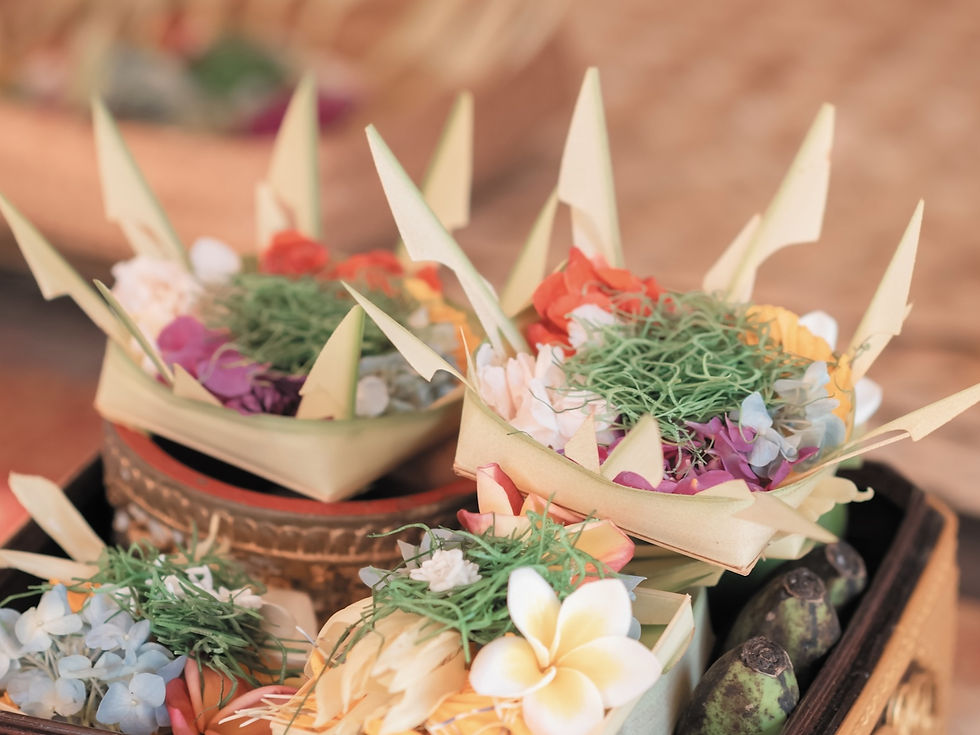EXPLORING THE SACRED TRADITIONS OF GALUNGAN AND KUNINGAN
- Niskala Team
- 3 days ago
- 3 min read
Bali is an island known for its spiritual beauty, deeply rooted rituals, and vibrant festivals. Among the most cherished are the sacred traditions of Galungan and Kuningan—ceremonies that celebrate the victory of dharma (good) over adharma (evil), and the sacred connection between the living and their ancestral spirits.
Galungan: A Celebration of Dharma
Galungan is an auspicious period during which Balinese Hindus believe that the ancestral spirits return to earth. Celebrated every 210 days, Galungan symbolizes the victory of dharma (good) over adharma (evil). Homes, temples, and streets are adorned with penjor—tall, intricately decorated bamboo poles that represent the towering presence of the gods. The festival is a time for reflection, communal rituals, and joyous feasting, as families come together to honor their ancestors and gods.

Kuningan: The Culmination of Spiritual Blessings
Kuningan follows Galungan after a period of 10 days. This festival marks the moment when the blessings of the gods are believed to reach their full fruition and the ancestral spirits prepare to return to the spiritual realm. During Kuningan, offerings are more elaborate, and the mood shifts slightly from the celebratory to the reflective, as participants bid farewell to the divine presence that has graced them. The name “Kuningan” itself is derived from the Indonesian word kuning, meaning yellow—the color traditionally associated with the sanctity and vibrancy of the festival.

Integration into Daily Life
For centuries, these festivals have shaped not only religious practices but also the social fabric of Balinese communities. The preparation for Galungan and Kuningan involves months of ritual cleansing, artistic preparation, and the crafting of offerings. Every element—from the food prepared for communal feasts to the decorative motifs on the penjor—is imbued with symbolism, making the entire process a living expression of faith and cultural identity.
The Making of Offerings
Central to both Galungan and Kuningan is the elaborate process of making offerings. Known as canang sari, these are small trays made of woven palm leaves that hold a variety of symbolic items such as flowers, fruits, incense, and rice. Each offering is meticulously arranged to honor the gods and welcome ancestral spirits, echoing the belief that the divine is present in everyday life.

Temple Ceremonies and Community Gatherings
Temples across Bali become vibrant centers of activity during these festivals. Ceremonies that include prayer, dance, and music illustrate the shared belief in the cyclical nature of life and the importance of balance between the material and spiritual worlds. In addition to temple ceremonies, village members often organize communal feasts and traditional dance performances, reinforcing community bonds and celebrating their shared heritage.

The Symbolic Significance of the Penjor
One of the most iconic symbols associated with Galungan is the penjor. These tall, kite-like structures made from bamboo and decorated with colorful ornaments stand as a visual reminder of the gods’ presence and the enduring strength of divine order. Erected outside homes and along main pathways, the penjor serves as both an invitation to the celestial beings and an expression of hope for a prosperous year ahead.
Visiting Bali During Galungan and Kuningan
Traveling to Bali during these holidays offers a truly immersive cultural experience. While some tourist activities may be limited due to temple ceremonies and family gatherings, witnessing the devotion and beauty of the celebrations can be unforgettable.
Be respectful of local customs, dress modestly if you plan to visit temples, and don’t hesitate to ask questions – most Balinese are happy to share the meaning behind their traditions.

Comments